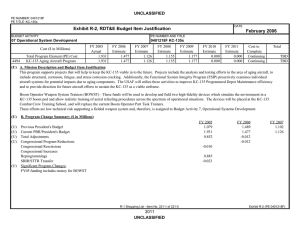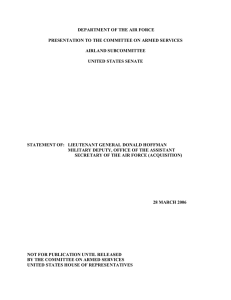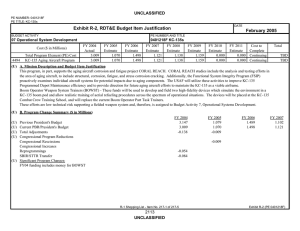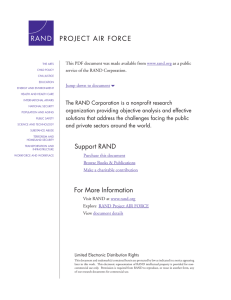DEPARTMENT OF THE AIR FORCE PROJECTION FORCES SUBCOMMITTEE
advertisement
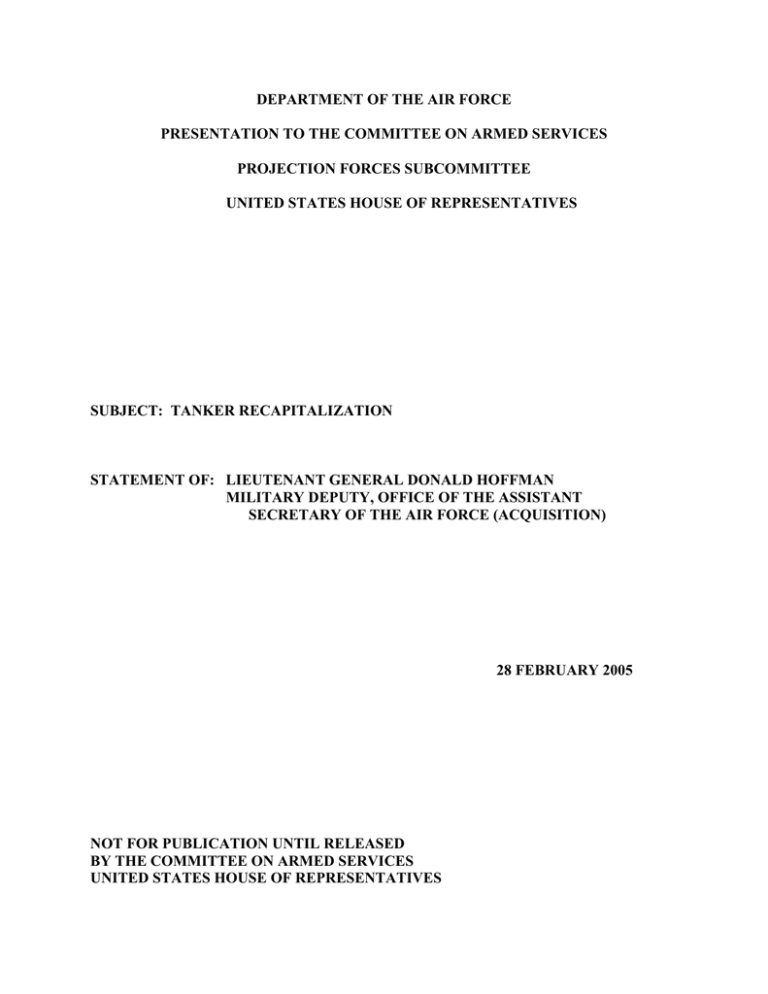
DEPARTMENT OF THE AIR FORCE PRESENTATION TO THE COMMITTEE ON ARMED SERVICES PROJECTION FORCES SUBCOMMITTEE UNITED STATES HOUSE OF REPRESENTATIVES SUBJECT: TANKER RECAPITALIZATION STATEMENT OF: LIEUTENANT GENERAL DONALD HOFFMAN MILITARY DEPUTY, OFFICE OF THE ASSISTANT SECRETARY OF THE AIR FORCE (ACQUISITION) 28 FEBRUARY 2005 NOT FOR PUBLICATION UNTIL RELEASED BY THE COMMITTEE ON ARMED SERVICES UNITED STATES HOUSE OF REPRESENTATIVES Mr. Chairman and distinguished members of the committee, thank you for the opportunity to appear before you today to discuss the Air Force’s plans and program in the FY07 President’s Budget request to recapitalize the KC-135 fleet. Our Joint Warriors are the best in the world. However, they can only be as effective as the tools we give them. Within today’s fiscal constraints, we must fight the Global War on Terror (GWOT) and protect the homeland while transforming the force and maintaining an appropriate level of risk. The Air Force is committed to balance the health of today’s force with the modernization and recapitalization necessary for the capabilities of the future. The Air Force appreciates all the support this committee has provided to the warfighter and ongoing operations around the world. The Air Force has three priorities: winning the war on terror, developing and caring for our Airmen, and maintaining, modernizing and recapitalizing our aircraft and equipment to meet the nation’s requirements. We are operating the oldest inventory of aircraft in our history, while maintaining the intense Operations Tempo (OPSTEMPO) required by the GWOT, humanitarian crises, and routine requirements. Today, the current KC-135 fleet of 531 aircraft has an average age of 45 years. The KC-135 was developed during the Cold War era with the primary purpose of refueling the B-52 in support of the Single Integrated Operations Plan. The KC-135 role expanded during the Vietnam War to support tactical combat and combat support missions. Now, in the post-Cold War and GWOT environment, the KC-135 serves as a critical joint force enabler…it is key to this nation’s ability to project joint power globally. The aircraft’s primary role still supports tactical combat and combat support missions; however, the environment in which it operates and the extent of its mission has changed dramatically with the evolution of technology, both that of our enemies and ours. This change calls for a tanker with greater 1 capabilities. The tanker fleet operates in an increased threat environment with Man-Portable Air Defense Systems (MANPADS) becoming more prolific every day, driving the need for defensive systems on our aircraft. The requirement to operate in blacked out conditions is expanding with the threat, calling for an integrated Night Vision Imaging System (NVIS) capability with compatible lighting. Joint and allied operations are increasing, meaning we need to expand our ability to provide both boom/receptacle and probe/drogue refueling on the same sortie, whenever it might be needed. One thing is certain, the tanker fleet of the future must be able to sustain the intense OPSTEMPO as well as support the increasing complexity of our operations. At the same time the KC-135 mission has evolved, the cost to operate the aging KC-135 fleet has been increasing as well as the sustainment costs. RAND, in their Analysis of Alternatives (AoA) for KC-135 Recapitalization, was not able to determine whether the fleet would or would not be able to last until 2050, the window of their analysis, but they did state that substantial technical uncertainties exist about the future health of the KC-135 fleet. The Air Force Fleet Viability Board (FVB) analysis, without considering future uncertainties, estimated that composite availability for the fleet would drop below 65% starting as early as 2023. Given the projected support costs and reduced availability beyond this point, the FVB recommended retiring the “E” models as soon as possible, and completing recapitalization of the entire KC-135 fleet no later than 2030. The KC-135E models are the oldest and least capable tankers in our inventory and are now used primarily for stateside training, homeland defense, and air bridge activities. In the FY07 President’s Budget request, the Air Force has requested to retire the KC-135E models: 78 in FY 07 and the remaining 36 in FY08 (114 total). The retirement of the KC-135E is critical to 2 the Air Force transformation roadmap, allowing the Air Force to divest some of our older, less capable, and most costly aircraft to free up funding to acquire newer aircraft with greater capability, increased availability and lower maintenance requirements/costs. As to the question of when the tanker replacement program should begin, we are currently working with the Office of the Secretary of Defense staff to finalize our recapitalization strategy and timing, while taking into consideration the studies completed to date. The two most recent studies are the Defense Science Board report, which recommended starting recapitalization in 2007, and RAND’s Analysis of Alternatives (AoA) for KC-135 Recapitalization. The AoA looked extensively at the question of when to start. Using net present value analysis of lifecycle costs, RAND concluded that the total cost of operating the KC-135s until they are retired, acquiring and operating the replacement aircraft, is relatively insensitive to both the timing and duration of recapitalization. Given the overall life cycle costs remain effectively constant regardless of when you start, RAND concluded that factors other than life cycle cost should drive the decision of when to recapitalize. Therefore, the AoA concluded that the decision should be based upon operational capability and risk considerations, confidence in the health of the existing fleet and near and long-term annual affordability constraints. The RAND AoA considered numerous alternatives for recapitalizing the fleet, including re-engined KC-135E models, commercial air-refueling services, new tanker designs, military derivatives, unmanned and stealth tankers, and commercial derivatives, both new and used. After almost two years of analysis, RAND concluded that the most cost-effective recapitalization option is the purchase of a fleet of medium to large-sized commercial derivative tankers 3 (300,000 to 1,000,000-pound maximum take-off gross weight) and recommended a full and open competition to gain best value to the government. The tanker replacement program and FY07 budget request were based on a competitive procurement of a commercial derivative tanker with a notional contract award in FY07 and first delivery in FY10. The FY07 program budget also builds upon FY05 and FY06 legislation regarding tanker replacement and the stated congressional intent to procure 100 aircraft within 10 years. Presently, the Air Force tanker recapitalization efforts are on pause until the Under Secretary of Defense for Acquisition Technology and Logistics (USD (AT&L)) provides the Air Force direction to resume. When we receive direction from to resume, we will work with the USD (AT&L) to develop the appropriate acquisition strategy and timing. This acquisition strategy will take into account the warfighters’ requirements, the recent KC-135 Recapitalization Analysis of Alternatives, the Mobility Capability Study, affordability concerns, and the material condition of the KC-135 fleet. We recognize that the funding profile will then need to be refined to reflect this strategy, particularly in light of the current program pause. We remain dedicated to ensuring that our warfighters, both present and future, continue to have this critical capability. Again, I appreciate the support provided by Congress and look forward to working with this Committee to best satisfy our warfighter needs in the future. 4


![[STORY ARCHIVES IMAGE]](http://s3.studylib.net/store/data/007416224_1-64c2a7011f134ef436c8487d1d0c1ae2-300x300.png)

